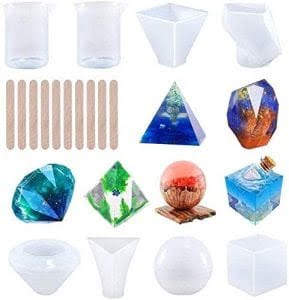When it comes to making candles, one of the most important aspects is ensuring that the wick remains straight throughout the process. A straight wick not only improves the aesthetics of the candle but also plays a crucial role in its burning performance.
Without proper wick alignment, you may encounter issues such as uneven melting, tunneling, or even extinguishing. In this article, we will delve into the importance of keeping the wick straight in candle making and provide you with essential tips and techniques to achieve this crucial element.
A straight wick is vital for optimal candle burning. When lit, a properly aligned wick ensures a steady and consistent flame. This allows for an even melting of the wax, preventing any potential problems like tunnelling or incomplete burn pools. Additionally, a straight wick helps maintain a strong and constant heat source, maximizing fragrance throw and ensuring that your candle burns longer and more efficiently.
Choosing the right wick plays a significant role in achieving a straight burn. The size and material of the wick depend on various factors such as container size, type of wax used, desired burn time, and scent load. Different wicks have different structures and burn rates; selecting an appropriate one will greatly influence the overall performance of your candle.
In this article, we will guide you through each step necessary to keep your wick perfectly aligned throughout the entire process: from preparing your candle container for proper placement to anchoring it securely during pouring. We will also share expert techniques for achieving a straight pour when working with hot wax and offer troubleshooting advice for common issues that may arise during wick placement.
Stay tuned as we explore all aspects of maintaining a beautifully straight-wicked candle – because paying attention to this small detail can make all the difference between an ordinary candle and an extraordinary one that fills your space with warmth, ambiance, and heavenly scents.
Understanding the Role of a Straight Wick in Candle Burning
A properly placed and straight wick is crucial for a successful and enjoyable candle-burning experience. When a wick is not straight, it can lead to issues such as uneven burning, excessive smoking, and tunneling. Understanding the role of a straight wick in candle burning will help you appreciate the importance of maintaining proper wick placement.
Even Burning
One of the primary reasons why a straight wick is essential is to ensure an even burning throughout the candle’s life. When a wick is positioned off-center or at an angle, it can cause the wax to melt unevenly. This results in one side of the candle melting faster than the other, leading to an uneven surface and potentially wasting some wax.
Minimal Smoking
A straight wick also helps minimize smoking when the candle is lit. When the wick leans towards one side or isn’t centered correctly, it may not receive enough oxygen during burning. This lack of oxygen can cause incomplete combustion and produce excess soot and smoke, which are not only unpleasant but can also be harmful to breathe in.
Preventing Tunneling
Tunneling refers to a situation where only a small portion of the wax around the wick melts while leaving excess wax around the edges untouched. An improperly placed wick contributes significantly to tunneling because it doesn’t distribute heat evenly across all areas of the container. This can result in wasted wax and make your candle burn out more quickly than expected.
By understanding these key roles played by a straight wick in candle burning, you can see why achieving proper wick placement is crucial for creating candles that burn evenly, produce minimal smoke, and avoid tunneling issues. In the next section, we will explore how to choose the right wick for your candle-making project based on these factors.
Choosing the Right Wick for Your Candle
When it comes to making candles, choosing the right wick is essential in ensuring a straight burn and a well-performing candle. The wick plays a crucial role in how your candle burns, including factors such as flame size, wax consumption, and even scent throw. Here are some tips to help you choose the right wick for your candle-making project:
- Consider the diameter of your container: The size of your candle container will determine the size of wick needed. A general rule of thumb is to choose a wick that is approximately the same width as the diameter of your container. This will allow for an even burn across the surface of the wax.
- Evaluate the type of wax you’re using: Different types of wax have varying melting points and densities, which can affect how a candle burns. For example, soy wax tends to have a lower melting point than paraffin wax. It’s important to choose a wick that is compatible with the specific characteristics of your chosen wax.
- Consider additives or fragrance oils: If you plan to add any additives or fragrance oils to your candle, keep in mind that these can also impact how your wick performs. Some fragrances or additives may require a larger or smaller wick size to ensure optimal burning.
- Test before committing: Before settling on a particular type or size of wick, it’s always recommended to conduct small test burns with different options. This will allow you to observe how each wick performs in terms of flame height, flickering, smoke production, and overall burn quality.
By carefully considering these factors and conducting proper testing, you’ll be able to select the ideal wick for your candle-making project. Remember that every candle is unique and may require different considerations when it comes to selecting the right wick; what works for one candle may not work for another.
Preparing Your Candle Container for Wick Placement
When it comes to making candles, preparing your candle container for wick placement is an essential step in ensuring that the wick stays straight throughout the burning process. Proper preparation will not only help the wick stay in place but also prevent any mishaps or accidents while the candle is lit. Here are some steps to follow when preparing your candle container for wick placement:
- Clean and dry your container: Before placing the wick, make sure that the container is clean and free from any dust, debris, or residue. Use a mild detergent and water mixture to wash the inside of the container, rinsing thoroughly to remove any soapy residue. Once cleaned, allow the container to completely dry before proceeding with wick placement.
- Measure and mark the center: To ensure that your wick stays straight in the candle, you need to locate and mark the center of the container. Measure from one side of the container’s rim to another diagonally, then use a marker or a piece of tape to mark this point at the bottom of the container. This will serve as your guide for accurate wick placement.
- Secure the metal base: Many pre-tabbed wicks come with metal bases attached to them. Place a small dot of hot glue at the bottom center of your container and press down firmly onto it with the metal base of your chosen wick. The hot glue will act as an adhesive and keep your wick securely in place during pouring and burning.
- Repeat if necessary: If you plan on making multiple candles using different containers, repeat these steps for each one individually. Each candle may require its own measurement and specific placement technique depending on its size and shape.
Following these steps will ensure that your candle container is properly prepared for wick placement, setting you up for success in achieving a beautifully straight-wicked candle. Taking these extra precautions at this stage will save you time and frustration in later steps of the candle making process.
Step-by-Step Guide
Once you have chosen the right wick and prepared your candle container, it is time to anchor the wick in place. This step is crucial for ensuring that the wick remains straight throughout the candle-making process. Follow this step-by-step guide to properly anchor the wick in your candle container:
- Measure and cut the wick: Start by measuring and cutting your wick to a length that allows for at least two inches of excess above the rim of your candle container. This extra length will be useful when it comes time to light the candle.
- Preparing the tab: Take one end of your wick and thread it through a metal tab or knot it around a wick stick, depending on the type of wick you are using. Make sure that the tab is securely attached to the end of the wick.
- Anchoring the tab: If you are using a metal tab, place it at the bottom center of your candle container. Ensure that it is flat against the bottom surface and press down firmly to secure it in place. If you are using a wick stick, gently push it into the bottom center of your container until it is anchored securely.
- Centering the wick: Hold onto the excess length of your wick and gently pull upwards, making sure that it remains centered in your container. You can use a clothespin or similar tool to hold onto the excess length while you pour in the wax later on.
Following these steps will properly anchor your wick in the candle container, laying a solid foundation for a straight and successful candle-making process.
| Step | Description |
|---|---|
| Measure and cut | Measure and cut the wick to a length that allows for at least two inches of excess above the rim of your candle container. |
| Prepare the tab | Thread one end of the wick through a metal tab or knot it around a wick stick, depending on the type of wick being used. |
| Anchor the tab | If using a metal tab, place it flat against the bottom center of your container and press down firmly. If using a wick stick, gently push it into the bottom center of your container until anchored securely. |
| Center the wick | Pull upwards on the excess length of the wick while ensuring that it remains centered in your container. You can use a clothespin or similar tool to hold onto the excess length during pouring. |
Techniques for Ensuring a Straight Wick While Pouring the Wax
Pouring the wax into the candle container is a crucial step in candle making that requires careful attention to ensure a straight wick. Without proper techniques, the wick may become crooked or tilted, affecting the burning process and aesthetic appeal of the finished candle. Here are some techniques to help you ensure a straight wick while pouring the wax:
- Centering Tools: Using centering tools can greatly help in keeping the wick straight while pouring the wax. One common tool is a wick holder or centering device that keeps the wick in place at the center of the container during pouring. These tools are usually made of metal and have hooks or clips that hold onto the wick, preventing it from moving out of place.
- Hand Guidance: Another technique is to manually guide the wick into place as you pour the wax. This can be done by using a small pencil or wooden stick to gently nudge and adjust the position of the wick as you pour. Keep an eye on both ends of the wick to ensure it remains centered in the container.
- Slow Pouring: Pouring slowly and steadily can also contribute to keeping a straight wick. Rapid pouring can cause turbulence, which can disturb and displace the wick. By pouring at a controlled pace, you minimize disturbance and give yourself more control over guiding and positioning the wick during this critical phase.
It’s also important to note that maintaining a steady hand is crucial when using these techniques. Any sudden jolts or movements may cause the wax to splash, potentially derailing your efforts to keep a straight wick.
In addition, periodically checking and readjusting the position of your centering tool or manually guiding technique throughout your pour is recommended. This will help ensure that any shifts in position are corrected before they become permanent.
By applying these techniques, you’ll have a greater chance of achieving a beautifully centered and straight wick during the wax pouring process, setting the stage for a successful candle-making experience overall.
| Techniques | Description |
|---|---|
| Centering Tools | Using metal wick holders or centering devices to keep the wick in place at the center of the container. |
| Hand Guidance | Manually adjusting and positioning the wick using a small pencil or wooden stick as you pour the wax. |
| Slow Pouring | Pouring the wax slowly and steadily to minimize turbulence and allow for better control over guiding and positioning the wick. |
Tips and Tricks for Maintaining a Straight Wick Throughout the Cooling Process
Throughout the cooling process of candle making, it is important to ensure that the wick remains straight to achieve a beautifully finished product. Here are some useful tips and tricks to help you maintain a straight wick as your candle cools.
One useful technique is to create a support for your wick during the cooling process. This can be achieved by using tools such as popsicle sticks or clothespins. Simply position the sticks or clothespins on either side of the wick, ensuring that they are tall enough to keep the wick suspended in a straight line. This will prevent the wick from bending or leaning as the wax solidifies.
Another helpful tip is to periodically check on your candle as it cools. As the wax solidifies, it may cause slight shifts in the position of the wick. Keeping an eye on your candle and gently adjusting the wick if needed can help maintain its straightness. It is important to do this carefully and avoid disturbing the cooling wax too much, as excessive movement can create air pockets or imperfections in your candle.
Additionally, consider using a mold release spray or lining your mold with parchment paper. This can help facilitate easy removal of the cooled candle, reducing any potential disturbances to the wick during this process.
By following these tips and tricks, you can ensure that your candle maintains a straight wick throughout its cooling process. With proper attention and care, you’ll be able to enjoy a beautifully finished candle that burns evenly and effectively every time.
Troubleshooting
Uneven Burning
One of the most common issues with wick placement is uneven burning. This occurs when the wick is not centered or straight, causing one side of the candle to burn faster than the other. To fix this problem, you will need to carefully adjust the position of the wick.
To begin, extinguish the candle and allow it to cool completely. Using a pair of tweezers or a wick centering tool, gently nudge the wick towards the center of the candle. Be careful not to apply too much pressure, as this can cause the wax to crack or break. Continue adjusting and centering the wick until it is in the desired position.
If you find that your candle is still burning unevenly after multiple adjustments, it may be necessary to melt down and remold your candle. This ensures that the wax is evenly distributed around the wick and can help prevent future issues with uneven burning.
Mushrooming
Mushrooming refers to the excess carbon buildup that accumulates on top of a burning wick, resulting in a large black dome shape resembling a mushroom. This not only affects the aesthetics of your candle but can also lead to poor burn performance and excessive soot emission.
To fix mushrooming, trim down your wick before each use. Use a pair of scissors or a wick trimmer to cut off any mushroomed carbon buildup as well as any long or curled sections of the wick. Aim for a length of around ¼ inch (6 millimeters) for optimal performance.
In addition to regular trimming, it’s important to choose an appropriate wick size for your specific candle diameter and type of wax. A properly sized wick will help minimize mushrooming and ensure an even burn throughout the life of your candle.
Sinking Wick
Another common issue with wick placement is a sinking wick. This occurs when the wick begins to sink into the melted wax pool as the candle burns, making it difficult to relight or causing the flame to extinguish prematurely.
To fix a sinking wick, carefully use a wick tab or heat-resistant object (such as a metal paperclip) to gently push the wick back up towards the surface of the wax. Be cautious not to apply too much force or disturb the wax too much, as this can cause the candle to spill over.
If you find that your wick continues to sink even after adjusting it multiple times, it may be necessary to pour out some of the excess melted wax. By reducing the depth of the wax pool, you can help prevent further sinking and ensure that your candle burns properly.
Conclusion
In conclusion, maintaining a straight wick when making candles is crucial for ensuring a clean and well-performing candle. A straight wick allows for even burning and prevents tunneling or uneven wax consumption. By following the steps outlined in this article, you can enjoy the fruits of your effort and create a beautifully straight wick candle.
Choosing the right wick for your candle is the first step in achieving a straight burn. Consider factors such as the diameter of your container and the type of wax you are using to select an appropriate wick size. Properly preparing your candle container by attaching a metal tab to the bottom of the wick helps anchor it in place during pouring.
Throughout the pouring process, it’s important to use techniques that ensure a straight wick. Pouring at the correct temperature and pouring slowly can help avoid any movement or displacement of the wick. Additionally, gently tapping or nudging the container after pouring can help align any skewed wicks.
Maintaining a straight wick during cooling is also essential. Avoid moving or adjusting the candle while it sets, as this can disrupt the position of the wick. Be patient and allow sufficient time for your candle to cool completely before trimming or lighting.
By practicing these techniques and troubleshooting any issues that may arise, you can achieve a beautifully straight-wicked candle that burns evenly and lasts longer. Enjoy the relaxing ambiance and delightful fragrance that your homemade candles provide, knowing that your attention to detail resulted in a high-quality finished product. Happy candle making.
Frequently Asked Questions
How do you keep candle wicks upright?
To keep candle wicks upright, there are a few steps you can take. Initially, it is important to trim the wick to about 1/4 inch before each use. Trimming the wick helps to prevent it from bending or leaning in the candle’s melted wax.
Another way to keep candle wicks upright is to make sure they are centered when pouring the wax into the container or mold. Additionally, using a wick stabilizer or a pencil laid across the container can provide support and keep the wick in an upright position as the candle burns.
Do candle wicks need to be straight?
While straightness is not absolutely necessary, it does play an important role in ensuring that candles burn properly and without issues. Having a straight wick allows for an even distribution of heat throughout the wax pool, which enables the candle to burn uniformly.
If a wick is crooked or bent, it may result in an uneven burn, causing tunneling or excessive soot buildup. Furthermore, if a wick is too long or has multiple bends, it can become difficult to ignite or stay lit during burning.
Why does my wick bend?
There are several reasons why a candle wick may bend while burning. One common cause is improper placement of the wick during manufacturing or pouring of the candle. If the wick was not centered properly when the hot wax was poured into its container, it can tilt and bend as it solidifies in an off-center position.
Another reason for a bent wick could be excessive drafts or air currents around the burning candle. Strong gusts of wind or nearby fans can disrupt the flame’s stability and cause the wick to lean or bend due to uneven heat distribution. Additionally, if there is excessive moisture in the surrounding environment or within the wax itself, this can lead to uneven burning and potentially cause a bent wick.

Welcome to my candle making blog! In this blog, I will be sharing my tips and tricks for making candles. I will also be sharing some of my favorite recipes.





